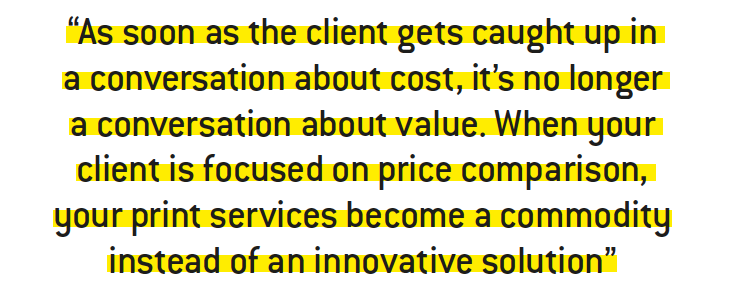The language of value
Branding and design columnist Vicki Strull offers tips for moving the conversation beyond price

Branding and design columnist Vicki Stull offers tips for moving the conversation beyond price
Let me paint a picture that’s probably familiar to most of you: You meet with a client or a brand team about their latest product and packaging needs. They’re excited, you’re excited, the ideas are flying. You’re wowing them about what you can do with embellishments, tactics, finishings and more. Then they ask you how much those special features are going to cost, and the conversation comes to a screeching halt.
It’s a reality in our business: As soon as the client gets caught up in a conversation about cost, it’s no longer a conversation about value. Even more distressing, when your client is focused on price comparison, your print services become a commodity instead of an innovative solution.
So how do you avoid this conversational rabbit hole? By steering the conversation away from price and instead speaking the language of business. When you think about it, our customers may have roles in procurement, sales, operations, finance, marketing or other areas. Their focus is not so much on the substrate or finishing we’re recommending, but on their business goals and how the project can meet them. For example, in conversations with finance, earnings are the priority; in conversations with marketing, consumer engagement is the focus. Talking with clients in their language, using the business terms they use, reshapes conversations from subjective to objective; it allows us to discuss the ‘why’ behind certain materials and designs and how those elements can achieve their specific business goals. But first, we have to understand just what those business goals are. And that means speaking ‘the language of business.’
Just as in the labels and packaging world, the world of business has a long list of relevant terms.
I’ve narrowed it down to what I call ‘the business six’ – the top six terms that should be in every designer’s and converter’s business vocabulary. When we understand these terms, synthesize them, and use them correctly in conversations and meetings, we’re no longer just talking about presses, run rates, inline, offline, CMYK, extended gamut, etc. Instead, we’re talking about economics. We’re talking about sales goals, revenue projections, customer value and strategies for gaining market share.
‘The business six’ are tools we can use to expand our credibility and impact. Once we understand our client’s goals, then when we do share our knowledge about the advantages of a particular technique, substrate or embellishment, we can frame our printing expertise and behavior-based knowledge within those goals. You’ll find that clients are more receptive to your input when the point you make is in their language with their goals top of mind.
1: Revenue
Let’s kick off ‘the business six’ with revenue. Revenue is simply the money that a company receives in exchange for its products and/or services. Now, there are a lot of terms that are associated with revenue. You might hear gross revenue, net revenue and top line. For example, gross revenue (also called top line) is the total amount of money a business receives from its sales. Net revenue is the amount of money a business makes from sales minus the expenses the business incurred making that product or providing that service. The exact word a person uses often depends on their role. I’ve been in cross-functional meetings that include the CEO, CFO, plus someone from sales, operations and HR. With so many different points of view, one person might use the term top line, while someone else uses the term gross revenue. They are talking about the same thing.
2: Margin
The second term in ‘the business six’ is margin. Margin is typically discussed as a ratio. (If you know all about margin, feel free to skip ahead). Let’s say a company has a product that sells for 10 USD and the cost of producing that product is 8 USD. That means the company has 2 USD left. Two dollars out of 10 is one-fifth; the margin, then, is 20 percent. Why is margin important to designers and converters? Often the budget for printing, design, branding, and marketing comes out of the product’s margin. When we’re in conversations with our clients, we want to understand where the budget is coming from so we can address it as their investment in their labels, packaging
and merchandising.
If we know the product’s margin, then we can predict a client’s receptivity to adding various finishing elements. This becomes even more enticing when we can tie those elements to their specific business goals. For example, an embellishment might enhance a brand’s position as the premium brand, which can help increase sales and capture additional market share. While the client may initially think the embellishment is too expensive, they may re-think the cost if the packaging drives volume, increases sales, and the company earns more – even though their margins are less. The point is, you’ll never know how to help clients meet their goals if you don’t ask what they are.
3: De-commoditize
De-commoditize is a cousin to ‘differentiate.’ When we’re developing packaging and labels, we are striving to differentiate the product so it doesn’t feel like everything else on the shelf. In contrast, a commodity is typically not branded. When you walk into The Home Depot to get nails, for example, you just pick out the size and type you need. They’re not branded, they’re a commodity. You’re buying them based on size, application, quantity and price.

Let’s look at spices to illustrate how branding and packaging can de-commoditize a product. For example, if we look at a pile of dried basil that’s not packaged, there is no doubt that it is a commodity. We’re thinking, ‘basil is basil.’ But companies like McCormick & Company, Simply Organic, Spice Islands, and others package basil differently so it’s elevated in the consumer’s mind. For example, McCormick has added a grinder to its dried basil packaging and it is able to charge about 11 USD an ounce (instead of 50 cents to 2 USD an ounce, the average price of loose dried basil without branding). In this case, the packaging contributed to McCormick’s pricing strategy and its premium positioning.
4: Market share
Market share is the percentage of sales within an industry that a particular brand achieves over a set period. For example, Domino’s, Papa John’s and Pizza Hut each have a certain market share in the pizza industry. If the business goal of the print piece I’m creating for a client is to help increase market share, I talk about how brand design and packaging can drive that. We discuss how improving conversions can increase sales to capture more market share. This conversation is not about special inks or foil stamps or how fast we can print. Yes, we care about that. But what gets your client excited? When you keep showing up as a true partner, providing solutions to help them achieve their goals.
5: Customer value
The fifth term is customer value. This is the calculation of how much a customer is worth during their relationship with a brand. It’s not only what the customer is currently spending, but also the amount they are projected to spend in the future. Additionally, customer value relates to how much and how frequently a customer posts online because social sharing can significantly influence others to become customers. The more a customer posts pictures or videos about a brand, its products, and the unboxing experience, plus the more followers they have, the greater their influence and the higher their customer value.
Relating that back to packaging design and development, if I suggest a finishing technique that makes the packaging more share-worthy but cuts into margins, I steer the conversation toward customer value and the brand’s social media goals, brand loyalty and customer acquisition.
6: Return on investment (ROI)
Our last term in ‘the business six’ is ROI – return on investment. I’m assuming you’re familiar with this term as a calculation that brands use to measure the profitability of an investment. But have you considered the differences between tangible and intangible ROI factors? Tangible ROI factors are quantifiable costs and benefits, such as production, materials, and design fees measured against the cost of conversions, sales and market share, for example. Intangible ROI factors are more qualitative and include factors of a customer’s experience, such as social sharing, brand loyalty and customers’ feelings of delight, satisfaction or frustration. Intangibles are more difficult to measure and are often undervalued in financial-based companies. However, intangible ROI factors are extremely valuable to the brand in terms of brand loyalty, brand trust and brand equity. I like to call these factors ‘return on impact.
It’s not just packaging; it’s packaging strategy
I’m sure you could add your own go-to business terms to ‘the business six.’ (Email me; I’d love to hear!)
It’s not only about what the terms are; it’s also about how you use them to strategize with your clients. Listen as your clients talk about their business challenges and objectives. Ask questions. Explain why the work you do has the potential to achieve their goals. Share success stories from your other projects. And keep the conversation focused on ‘the language of business’ and the value you bring to support your client’s business goals.
Stay up to date
Subscribe to the free Label News newsletter and receive the latest content every week. We'll never share your email address.


